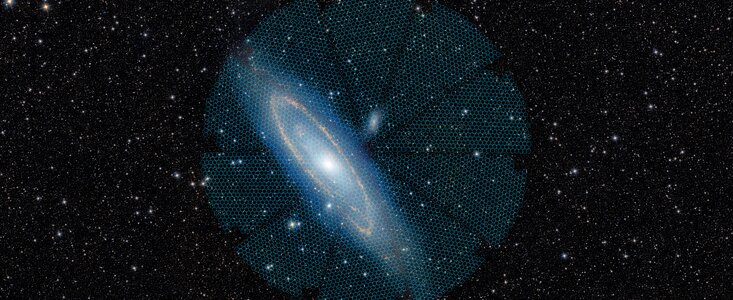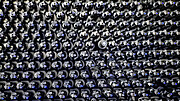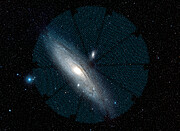DESI Begins Creating 3D Map of the Universe
The Dark Energy Spectroscopic Instrument (DESI) completes trial run, begins survey to map the Universe and unravel mysterious dark energy
17 May 2021
A quest to map the Universe and unravel the mysteries of dark energy began officially today, 17 May 2021, at Kitt Peak National Observatory, a Program of NSF’s NOIRLab. Over the next five years, the Dark Energy Spectroscopic Instrument (DESI) will capture the light from tens of millions of galaxies and other cosmic objects. During its four-month trial run, which just concluded, the project already collected millions of observations.
By gathering light from some 30 million galaxies, project scientists say that DESI will help them construct a 3D map of the Universe in unprecedented detail. DESI will do this by collecting spectra, which spread out the light from celestial objects into the colors of the rainbow, revealing information such as the chemical composition of the objects being observed and their relative distances and velocities. This data will help astronomers better understand the repulsive force associated with dark energy, which drives the acceleration of the Universe’s expansion across vast cosmic distances.
DESI is an international science collaboration managed by the US Department of Energy’s Lawrence Berkeley National Laboratory (Berkeley Lab) with primary funding from the Department’s Office of Science. DESI resides at the retrofitted Nicholas U. Mayall 4-meter Telescope at Kitt Peak National Observatory, a Program of NSF’s NOIRLab.
Jim Siegrist, Associate Director for High Energy Physics at DOE, said, “We are excited to see the start of DESI, the first next-generation dark energy project to begin its science survey. We also congratulate Berkeley Lab, which continues to enhance our capabilities for studying the nature of dark energy, since leading the initial discovery in 1999. DOE’s Berkeley Lab successfully led the 13-nation DESI team, including US government, private, and international contributions, in the design, fabrication, and commissioning of the world’s premier multi-object spectrograph. The strong interagency collaboration with NSF has enabled DOE to install and operate DESI on their Mayall telescope, which is required to carry out this amazing experiment. Along with its primary mission of dark energy studies, the data set will be of use by the wider scientific community for a multitude of astrophysics studies.”
"The combination of the Mayall telescope and DESI instrument is now the best astronomical survey machine on the planet,” said Arjun Dey, the DESI project scientist for NOIRLab and the DESI Observing Operations lead. “Its initial five-year mission, hopefully the first of many, will produce the most detailed cartographic map of our accelerating, expanding Universe ever created. I can't wait to see what it will discover!"
“The DESI experiment is an excellent example of the amazing science that can be achieved when government agencies collaborate to make the most of national observatory facilities like the Mayall telescope,” says Chris Davis, NSF Program Director for NOIRLab.
What sets DESI apart from previous sky surveys? “We will measure ten times more galaxy spectra than ever obtained,” said the project director, Berkeley Lab’s Michael Levi. “These spectra get us a third dimension.” Instead of two-dimensional images of galaxies, quasars, and other distant objects, he explained, the instrument collects light, or spectra, from the cosmos such that it “becomes a time machine where we place those objects on a timeline that reaches as far back as 11 billion years ago.”
“DESI is the most ambitious of a new generation of instruments aimed at better understanding the cosmos, in particular its dark energy component,” said project co-spokesperson Nathalie Palanque-Delabrouille, a cosmologist at France’s Alternative Energies and Atomic Energy Commission (CEA). She said the scientific program — including her own interest in quasars — will allow researchers to address with precision two primary questions: what is dark energy, and to what degree does gravity follow the laws of general relativity, which form the basis of our understanding of the cosmos.
“It's been a long journey from the first steps that we took almost a decade ago to design the survey, then to decide which targets to observe, and now to have the instruments so that we can achieve those science goals,” Palanque-Delabrouille said. “It's very exciting to see where we stand today.”
The formal start of DESI’s five-year survey follows a four-month trial run of its custom instrumentation that captured four million spectra — more than the combined output of all previous spectroscopic surveys. [1]
“It is extremely gratifying to see this incredible and innovative instrument perform so well at this critical point in the project,” said Parker Fagrelius, DESI Operations Supervisor at NOIRLab. “I am very excited to see what the DESI Survey can uncover about dark energy, but also what new and interesting phenomena we will discover along the way that we didn’t even know to look for!”
The instrument includes new optics that increase the field of view of the telescope and also includes 5000 robotically controlled optical fibers to gather spectroscopic data from an equal number of objects in the telescope’s field of view.
“We’re not using the biggest telescopes,” said David Schlegel, who is the DESI Project Scientist. “It’s that the instruments are better and very highly multiplexed, meaning that we can capture the light from many different objects at once.”
In fact, the telescope “is literally pointing at 5000 different galaxies simultaneously,” Schlegel said. On any given night, he explained, as the telescope is moved into a target position, the optical fibers align to collect light from galaxies as it is reflected off the telescope mirror. From there, the light is fed into a bank of spectrographs and CCD cameras for further processing and study.
“It’s really a factory that we have — a spectra factory,” said survey validation lead, Christophe Yeche, who is also a cosmologist at CEA. “We can collect 5000 spectra every 20 minutes. In a good night, we collect spectra from some 150,000 objects.”
“But it’s not just the instrument hardware that got us to this point — it’s also the instrument software, DESI’s central nervous system,” said Klaus Honscheid, a professor of physics at Ohio State University who directed the design of the DESI instrument control and monitoring systems. He credits scores of people in his group and around the world who have built and tested thousands of DESI’s component parts, most of which are unique to the instrument.
As the Universe expands, galaxies move away from each other, and their light is shifted to longer, redder wavelengths. The more distant the galaxy, the greater its redshift. By measuring galaxy redshifts, DESI researchers will create a 3D map of the Universe. The detailed distribution of galaxies in the map is expected to yield new insights into the influence and nature of dark energy.
“Dark energy is one of the key science drivers for DESI,” said project co-spokesperson Kyle Dawson, a professor of physics and astronomy at the University of Utah. “The goal is not so much to find out how much there is — we know that about 70% of the energy in the Universe today is dark energy — but to study its properties.”
The Universe is expanding at a rate determined by its total energy content, Dawson explained. As the DESI instrument looks out in space and time, “we can literally take snapshots today, yesterday, 1 billion years ago, 2 billion years ago — as far back in time as possible,” he said. “We can then figure out the energy content in these snapshots and see how it is evolving.”
Notes
[1] During its four-month trial run, DESI collected 4.3 million spectra, but many were repeat observations of the same objects.
More information
NSF’s NOIRLab (National Optical-Infrared Astronomy Research Laboratory), the US center for ground-based optical-infrared astronomy, operates the international Gemini Observatory (a facility of NSF, NRC–Canada, ANID–Chile, MCTIC–Brazil, MINCyT–Argentina, and KASI–Republic of Korea), Kitt Peak National Observatory (KPNO), Cerro Tololo Inter-American Observatory (CTIO), the Community Science and Data Center (CSDC), and Vera C. Rubin Observatory (in cooperation with DOE’s SLAC National Accelerator Laboratory). It is managed by the Association of Universities for Research in Astronomy (AURA) under a cooperative agreement with NSF and is headquartered in Tucson, Arizona. The astronomical community is honored to have the opportunity to conduct astronomical research on Iolkam Du’ag (Kitt Peak) in Arizona, on Maunakea in Hawaiʻi, and on Cerro Tololo and Cerro Pachón in Chile. We recognize and acknowledge the very significant cultural role and reverence that these sites have to the Tohono O'odham Nation, to the Native Hawaiian community, and to the local communities in Chile, respectively.
DESI is supported by the DOE Office of Science and by the National Energy Research Scientific Computing Center, a DOE Office of Science user facility. Additional support for DESI is provided by the US National Science Foundation, the Science and Technologies Facilities Council of the United Kingdom, the Gordon and Betty Moore Foundation, the Heising-Simons Foundation, the French Alternative Energies and Atomic Energy Commission (CEA), the National Council of Science and Technology of Mexico, the Ministry of Economy of Spain, and by the DESI member institutions.
The DESI collaboration is honored to be permitted to conduct astronomical research on Iolkam Du’ag (Kitt Peak), a mountain with particular significance to the Tohono O'odham Nation.
Current DESI Member Institutions include: Aix-Marseille University; Argonne National Laboratory; Barcelona-Madrid Regional Participation Group; Brookhaven National Laboratory; Boston University; Brazil Regional Participation Group; Carnegie Mellon University; CEA-IRFU, Saclay; China Participation Group; Cornell University; Durham University; École Polytechnique Fédérale de Lausanne; Eidgenössische Technische Hochschule, Zürich; Fermi National Accelerator Laboratory; Granada-Madrid-Tenerife Regional Participation Group; Harvard University; Kansas State University; Korea Astronomy and Space Science Institute; Korea Institute for Advanced Study; Lawrence Berkeley National Laboratory; Laboratoire de Physique Nucléaire et de Hautes Énergies; Max Planck Institute; Mexico Regional Participation Group; New York University; NSF’s NOIRLab; Ohio University; Perimeter Institute; Shanghai Jiao Tong University; Siena College; SLAC National Accelerator Laboratory; Southern Methodist University; Swinburne University; The Ohio State University; Universidad de Los Andes; University of Arizona; University of Barcelona; University of California, Berkeley; University of California, Irvine; University of California, Santa Cruz; University College London; University of Florida; University of Michigan at Ann Arbor; University of Pennsylvania; University of Pittsburgh; University of Portsmouth; University of Queensland; University of Rochester; University of Toronto; University of Utah; University of Waterloo; University of Wyoming; University of Zurich; UK Regional Participation Group; Yale University.
Founded in 1931 on the belief that the biggest scientific challenges are best addressed by teams, Lawrence Berkeley National Laboratory and its scientists have been recognized with 14 Nobel Prizes. Today, Berkeley Lab researchers develop sustainable energy and environmental solutions, create useful new materials, advance the frontiers of computing, and probe the mysteries of life, matter, and the universe. Scientists from around the world rely on the Lab’s facilities for their own discovery science. Berkeley Lab is a multiprogram national laboratory, managed by the University of California for the US Department of Energy’s Office of Science.
DOE’s Office of Science is the single largest supporter of basic research in the physical sciences in the United States, and is working to address some of the most pressing challenges of our time.
The National Science Foundation (NSF) is an independent federal agency created by Congress in 1950 to promote the progress of science. NSF supports basic research and people to create knowledge that transforms the future.
Established in 2007 by Mark Heising and Elizabeth Simons, the Heising-Simons Foundation is dedicated to advancing sustainable solutions in the environment, supporting groundbreaking research in science, and enhancing the education of children.
The Gordon and Betty Moore Foundation, established in 2000, seeks to advance environmental conservation, patient care, and scientific research. The Foundation’s Science Program aims to make a significant impact on the development of provocative, transformative scientific research, and increase knowledge in emerging fields.
The Science and Technology Facilities Council (STFC) of the United Kingdom coordinates research on some of the most significant challenges facing society, such as future energy needs, monitoring and understanding climate change, and global security. It offers grants and support in particle physics, astronomy, and nuclear physics.
Links
Contacts
Arjun Dey
NSF’s NOIRLab
Tel: +1 520-318-8429
Email: arjun.dey@noirlab.edu
Parker Fagrelius
NSF’s NOIRLab
Email: parker.fagrelius@noirlab.edu
Amanda Kocz
NSF’s NOIRLab
Tel: +1 626-524-5884
Email: amanda.kocz@noirlab.edu






